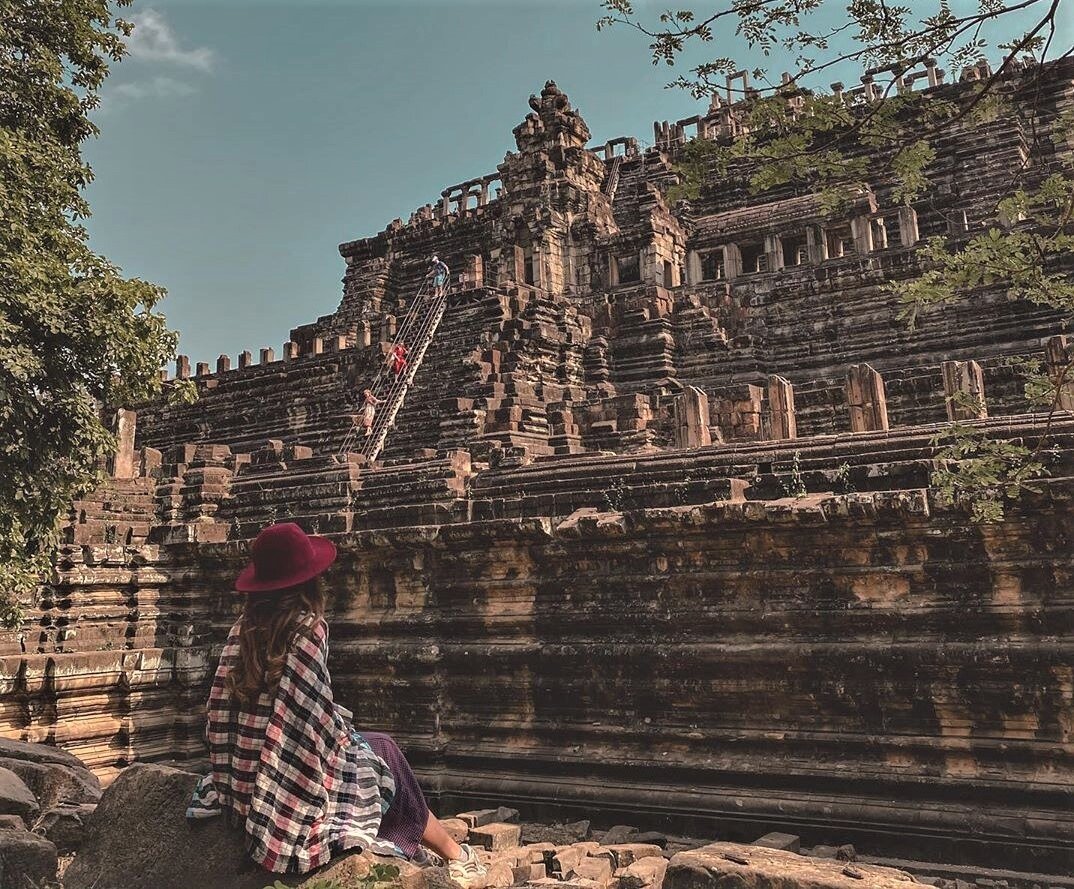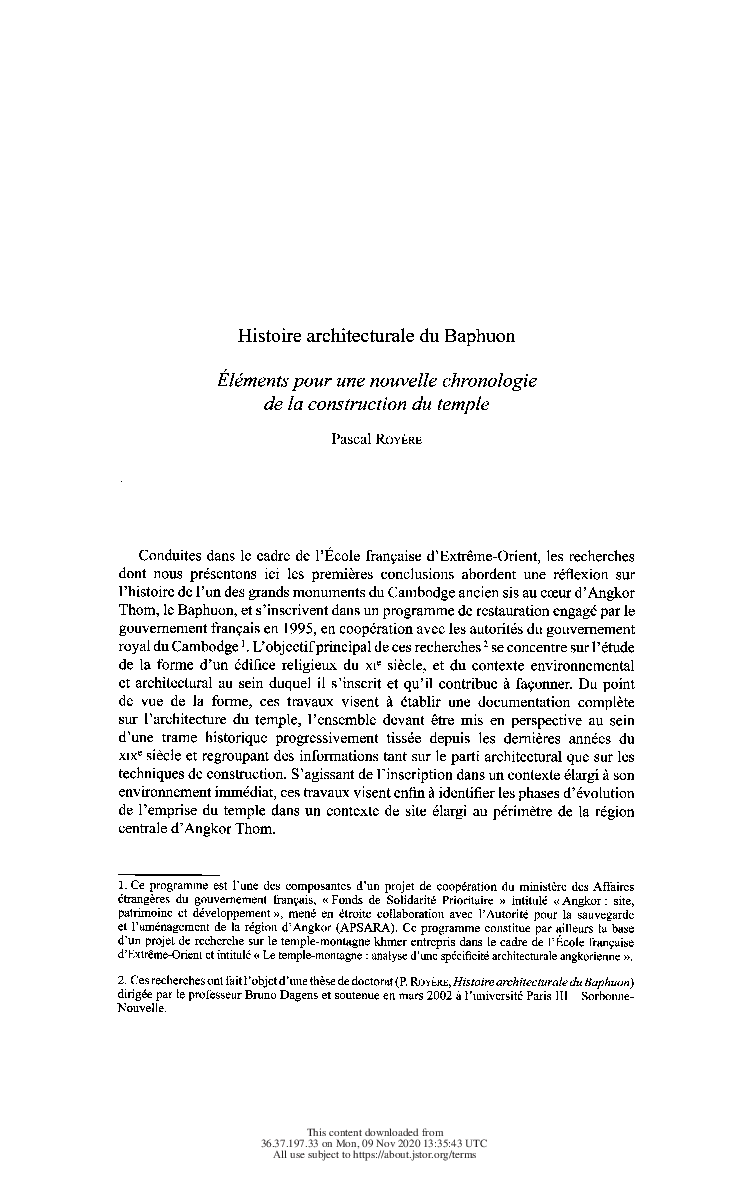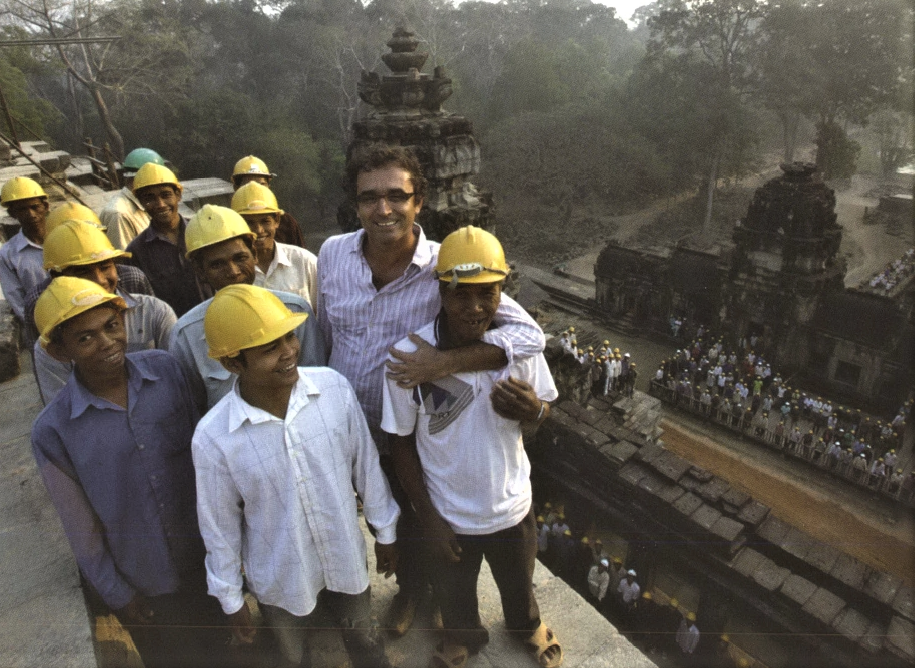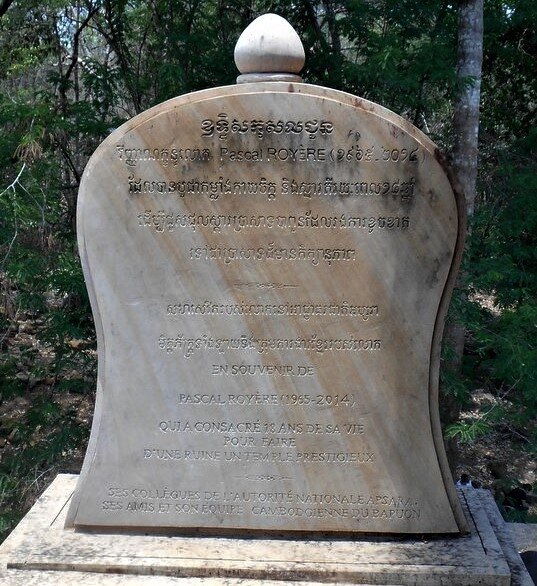Histoire architecturale du Baphuon / The Baphuon, Architectural History & Chronology
by Pascal Royère
How the particular spatial organization of this version of the 'temple-mountain' prefigured Angkor Wat.

- Publication
- Bulletin de l'École française d'Extrême-Orient , 2005, Vol. 92, pp. 391-455 / EFEO-JSTOR
- Published
- 2005
- Author
- Pascal Royère
- Pages
- 65
- Language
- French
pdf 3.6 MB
Is the name ‘Baphuon’ (ប្រាសាទបាពួន) in itself an indication of its specific conception as bhuvanatilaka, a building topped off by concentric galleries? The author, who directed the renovation works of this major temple-mountain dedicated to Shiva during 16 years (1995−2011), deems possible that the name might be a Khmerization of the Sanskrit Brah Bhuvanatylaka (Sacred Building with Upper Galleries).
This essay, so minutiously detailed that it might be read as an inspection report on the restoration work in progress, discusses many hypotheses regarding the different phases of extension and its adaptations to the Royal City masterplan, in development during the 11th century.
How the Baphuon might have inspired the builders of Angkor Wat itself, and later on those of the Koh Ker temple, is also a topic here considered.
About the connection with the Royal Palace
The leading specialist of the stunning Baphuon site after Jacques Dumarçay, the late Pascal Royere was still directing the temple restoration when he passed away in 2014.
In this riveting study, the author considers the changes in defence considerations through times, in particular after the Champa invasion at the start of the 12th century.
Among his considerations: ‘Les raisons pour lesquelles le temple est accolé à l’enceinte Sud du Palais Royal nous sont inconnues. Cependant cette disposition particulière, en rupture avec les habitudes précédentes, a sans doute contraint le modèle initial du Palais, entouré ici par une enceinte de latérite.’
‘En raison de cette nouvelle implantation, un certain nombre de structures ont été modifiées dans leur emprise et, sans doute, dans leur fonctionnement. A titre d’exemple, il nous manqué les tracés originaux des courettes devançant l’accès aux cinq gopuras du Palais. Mais l’on peut assurer que l’implantation de la double enceinte du Baphuon accolée contre ses douves sud en a très fortement perturbé le fonctionnement.’
‘Par conséquent, si la construction du Baphuon a, comme nous le pensons, contribué à la modification des aménagements des abords du Palais Royal, il est permis de penser que c’est d’un point de vue défensif que ces bouleversements ont été les plus ressentis par les maîtres d’oeuvre ; les dispositions originales devant être modifiées, notamment sur la face Sud, il est possible que l’enceinte originale du Palais se soit soudainement révélée insuffisante, ce qui aurait alors entraîné la construction d’une enceinte telle que nous la voyons encore aujourd’hui, enveloppant ces deux ensembles en débordant largement du cadre des douves Nord du palais, et renforçant de fait le lien entre le Palais Royal et le Baphuon.’
Full title: ‘Histoire architecturale du Baphuon, Eléments pour une nouvelle chronologie de la construction du temple’.
Photo: The Baphuon in 2019 (photo Sakphearoth Kea)
Tags: Baphuon, architecture, archaeology, temple-mountain, Queen Mother Monineath
About the Author

Pascal Royère
Initially a mason and building engineer in Southwest France like his father, Pascal Royère (6 July 1965 — 5 Feb. 2014, Villeneuve-lès-Boulloc) graduated the Ecole Nationale Supérieure d’Architecture in Nantes in 1994 with a restoration project dedicated to the Southern Kleang at Angkor Thom.
In 1993, he joined the EFEO Siem Reap branch to undertake several renovated projects as an archaeologist and architect. After perfecting his knowledge of Angkor history under the guidance of Bruno Daguens, Jacques Dumarçay and Christophe Pottier, he was appointed Director of the Baphuon Renovation Project in 1995, one of the major programs ran by Apsara Authority and EFEO.
Initially launched by Jean Commaille in 1908, developed by Bernard-Philippe Groslier in the 1950s and 1960s, suspended during the Cambodian civil war, the Baphuon site protection and renovation program was particularly complex, with more than 300,000 sandstone blocks, many weighing a half-ton, to be reassembled. Involving up to 250 workers and volunteers, the site was officially inaugurated by H.M. King Norodom Sihamoni on July 3, 2011.
After completing the Baphuon campaign, Pascal Royère, whom his Cambodian colleague had nicknamed ‘Pascal Thom’ (Big Pascal), was appointed EFEO Director of Projects in France, and started to work on a restoration program for the West Mebon when he passed away at 48 years of age only.
With the Baphuon site workers in 2010 (Photo Christophe Loviny)
Tribute to Pascal Royère at Wat Svay Romiet, Siem Reap.



